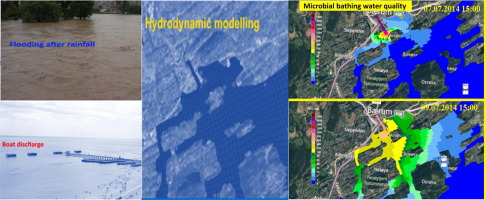当前位置:
X-MOL 学术
›
J. Hydrol.
›
论文详情
Our official English website, www.x-mol.net, welcomes your feedback! (Note: you will need to create a separate account there.)
Hydrodynamic modelling of recreational water quality using Escherichia coli as an indicator of microbial contamination
Journal of Hydrology ( IF 6.4 ) Pub Date : 2018-06-01 , DOI: 10.1016/j.jhydrol.2018.04.006 Fasil Ejigu Eregno , Ingun Tryland , Torulv Tjomsland , Magdalena Kempa , Arve Heistad
Journal of Hydrology ( IF 6.4 ) Pub Date : 2018-06-01 , DOI: 10.1016/j.jhydrol.2018.04.006 Fasil Ejigu Eregno , Ingun Tryland , Torulv Tjomsland , Magdalena Kempa , Arve Heistad

|
Abstract Microbial contamination of recreational beaches is often at its worst after heavy rainfall events due to storm floods that carry fecal matter and other pollutants from the watershed. Similarly, overflows of untreated sewage from combined sewerage systems may discharge directly into coastal water or via rivers and streams. In order to understand the effect of rainfall events, wind-directions and tides on the recreational water quality, GEMSS, an integrated 3D hydrodynamic model was applied to assess the spreading of Escherichia coli (E. coli) at the Sandvika beaches, located in the Oslo fjord. The model was also used to theoretically investigate the effect of discharges from septic tanks from boats on the water quality at local beaches. The model make use of microbial decay rate as the main input representing the survival of microbial pathogens in the ocean, which vary widely depending on the type of pathogen and environmental stress. The predicted beach water quality was validated against observed data after a heavy rainfall event using Nash-Sutcliffe coefficient (E) and the overall result indicated that the model performed quite well and the simulation was in – good agreement with the observed E. coli concentrations for all beaches. The result of this study indicated that: 1) the bathing water quality was poor according to the EU bathing water directive up to two days after the heavy rainfall event depending on the location of the beach site. 2) The discharge from a boat at 300-meter distance to the beaches slightly increased the E. coli levels at the beaches. 3) The spreading of microbial pathogens from its source to the different beaches depended on the wind speed and the wind direction.
中文翻译:

使用大肠杆菌作为微生物污染指标的娱乐水质水动力模型
摘要 在暴雨之后,休闲海滩的微生物污染往往最为严重,因为风暴洪水将粪便和其他污染物从流域带走。同样,来自联合污水处理系统的未经处理的污水溢出可能直接排放到沿海水域或通过河流和溪流。为了了解降雨事件、风向和潮汐对休闲水质的影响,GEMSS 应用了一个集成的 3D 流体动力学模型来评估大肠杆菌(E.coli)在位于 Sandvika 海滩的传播情况,位于奥斯陆峡湾。该模型还用于从理论上研究船舶化粪池排放对当地海滩水质的影响。该模型利用微生物衰减率作为主要输入,代表海洋中微生物病原体的存活情况,其根据病原体类型和环境压力的不同而有很大差异。使用 Nash-Sutcliffe 系数 (E) 对大雨事件后的观测数据对预测的海滩水质进行了验证,总体结果表明该模型运行良好,模拟结果与观测到的大肠杆菌浓度非常吻合所有海滩。这项研究的结果表明: 1) 根据欧盟沐浴水指令,在强降雨事件发生后两天内,沐浴水质较差,具体取决于海滩地点的位置。2) 距离海滩 300 米处的船只排放的污水,轻微增加了海滩的大肠杆菌水平。
更新日期:2018-06-01
中文翻译:

使用大肠杆菌作为微生物污染指标的娱乐水质水动力模型
摘要 在暴雨之后,休闲海滩的微生物污染往往最为严重,因为风暴洪水将粪便和其他污染物从流域带走。同样,来自联合污水处理系统的未经处理的污水溢出可能直接排放到沿海水域或通过河流和溪流。为了了解降雨事件、风向和潮汐对休闲水质的影响,GEMSS 应用了一个集成的 3D 流体动力学模型来评估大肠杆菌(E.coli)在位于 Sandvika 海滩的传播情况,位于奥斯陆峡湾。该模型还用于从理论上研究船舶化粪池排放对当地海滩水质的影响。该模型利用微生物衰减率作为主要输入,代表海洋中微生物病原体的存活情况,其根据病原体类型和环境压力的不同而有很大差异。使用 Nash-Sutcliffe 系数 (E) 对大雨事件后的观测数据对预测的海滩水质进行了验证,总体结果表明该模型运行良好,模拟结果与观测到的大肠杆菌浓度非常吻合所有海滩。这项研究的结果表明: 1) 根据欧盟沐浴水指令,在强降雨事件发生后两天内,沐浴水质较差,具体取决于海滩地点的位置。2) 距离海滩 300 米处的船只排放的污水,轻微增加了海滩的大肠杆菌水平。


























 京公网安备 11010802027423号
京公网安备 11010802027423号